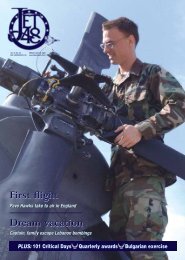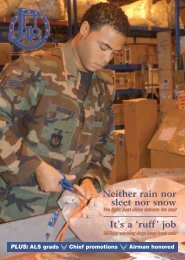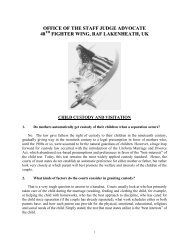12 - RAF Lakenheath - Air Force Link
12 - RAF Lakenheath - Air Force Link
12 - RAF Lakenheath - Air Force Link
Create successful ePaper yourself
Turn your PDF publications into a flip-book with our unique Google optimized e-Paper software.
Jet48PerspectiveThe challenging troopBy James Robb48th Mission Support Group Deputy CommanderOne of the leadership challenges many managers encounter throughouttheir careers is dealing with under-performers. As a leader, havingto be prepared to motivate and utilize “the hand you are dealt.”Sometimes that hand isn’t necessarily the best of the best.In this time of leaner management, <strong>Air</strong> <strong>Force</strong> Smart Operations21 and manpower reductions, the first inclination a leader may haveis to pull a Donald Trump with under-performers: “You’re fired!”While that may be the easiest course of action, it doesn’t deal withthe issue; it just moves it elsewhere. And, even worse, a replacementmight not be any better. Good leaders look under the roughpersona and find out what makes their people tick, leveraging positivequalities to better accomplish the mission. I have worked withmany “cast-offs” in my career and have come to realize often all aperson needs to succeedis a little redirectionand support.Tech. Sgt. “Paul,”for example, was anythingbut a superstar.He was an extremelyintelligent engineeringassistant draftsman, butwas apparently lazy orbored all the time. Hehad 18 years in the AFand was on profilebecause he was 30pounds overweight. Hehad been “fired” fromthree previous positionsin the squadron. Onewas because he made amistake in accounting.Another was becausehe was never at hisdesk and the third one was because he “couldn’t avoid” visitinginappropriate Web sites, he liked to spend hours at gaming sitesinstead of working. By all accounts, Paul was on a quick route outof the military.At this time, I needed someone to provide high quality renderingsof projects and three-dimensional pictures. Paul certainly wasgood as a two-dimensional draftsman, so I had nothing to lose bygiving him this task. I figured if I could capitalize on his draftingtalent and combine this with his love of gaming, I could get somereasonable 3-D drawings from him. I set him up in a workstation nottoo far from mine with new state-of-the-art equipment and top-ofthe-line software and got him the training to use it. Although all thisran about $7,500, it cost much less than an outside contractor wouldhave charged.At first, Paul started out okay, but after a couple weeks, he wasnever at his desk. Rather than working, he was usually leaningagainst the wall, shooting the breeze and wasting someone else’s“As leaders, our”JETjobs are to developour people’sstrengths and givethem the tools theyneed to succeed.time as well as his own. Rather than reprimand him, I would refocushis attention back to the task at hand, asking him where he was onthe project he was working. Then later that day, I would add anotherrequirement to his task list. After a couple weeks of this, Paul knewthat I was depending on him for results and not just giving him busywork as others had done in the past. I gave him a sense of purpose. Ialso took personal interest in what he was doing.Soon he was producing preliminary drawings that began to anticipatemy needs. As he worked, his skills increased and his reputationfor doing innovative and interesting work spread. Soon, people werecoming around and looking over his shoulder, watching what he wasdoing and asking for instruction. Others in his specialty started tocome to him for answers. He was no longer the laughing stock, butsomeone with talent. Rather than feeling worthless, he began tounderstand his value to the project, office and mission.I continued to counsel and encourage his interest in this field,because I knew he would have an uphill battle to re-enlist given hishistory and physical condition.Furthermore, I urged himto think of a future outsidethe military and the fee hisskills could claim in the privatesector. He soon learnedhow to do animation andother advanced skills on hisown, with no prodding fromme. The products he createdwere shown to the wingcommander, who loved themand demanded more.Inspiration, encouragementand success all had thedesired effect and prettysoon Paul was always at hisdesk working and pullinglonger hours than anyoneelse in the section, just to getit right. The under-performerhad evolved into the overachiever and a valuable asset to the office,wing and AF.Paul was with me for a year before he moved to another base.The flight chief at his new base praised him, relating back to methat he continued to develop his skills and produce the sameextraordinary results to their wing that he’d provided to ours. At theend of that tour, Paul retired and took a challenging job doing thesame work for an architect and engineer firm, setting himself up fora very comfortable second career.Some leaders deal with weaker elements by getting rid of thosethey feel don’t fit the mold. However, sometimes it just takes knowingyour people better, especially their talents and needs, and givingthem the opportunity to demonstrate what they can do.As leaders, our jobs are to develop our people’s strengths andgive them the tools they need to succeed. If we succeed in accomplishingthat goal as leaders, we will always end up with a betterorganization because of our efforts.MAY <strong>12</strong>, 200648 MAGAZINE PAGE 21
















